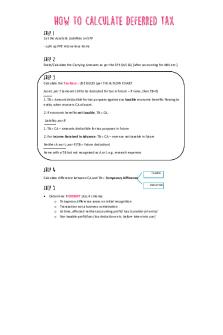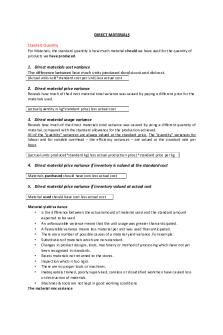Materials - Summary of how to calculate and analyse material\'s variance PDF

| Title | Materials - Summary of how to calculate and analyse material\'s variance |
|---|---|
| Author | Marina Skripnicenko |
| Course | Rural Business Management |
| Institution | Scotland's Rural College |
| Pages | 2 |
| File Size | 75.7 KB |
| File Type | |
| Total Downloads | 91 |
| Total Views | 135 |
Summary
Summary of how to calculate and analyse material's variance...
Description
DIRECT MATERIALS Standard Quantity For Materials, the standard quantity is how much material should we have used for the quantity of products we have produced.
1. Direct materials cost variance The difference between how much units produced should cost and did cost. (Actual units sold*standard cost per unit) less actual cost
2. Direct material price variance Reveals how much of the direct material total variance was caused by paying a different price for the materials used. (actual quantity in kg*standard price) less actual cost
3. Direct material usage variance Reveals how much of the direct materials total variance was caused by using a different quantity of material, compared with the standard allowance for the production achieved. All of the “quantity” variances are always valued at the standard price. The “quantity” variances for labour and for variable overhead – the efficiency variances – are valued at the standard rate per hour. ((actual units produced*standard kg) less actual production price) *standard price per kg
4. Direct material price variance if inventory is valued at the standard cost Materials purchased should have cost less actual cost
5. Direct material price variance if inventory valued at actual cost Material used should have cost less actual cost Material yield variance • is the difference between the actual amount of material used and the standard amount expected to be used • An unfavourable variance means that the unit usage was greater than anticipated. • A Favourable variance means less material per unit was used than anticipated. • There are a number of possible causes of a material yield variance. For example: • Substitution of materials which are non-standard. • Changes in product designs, tools, machinery or method of processing which have not yet been recognized in standards. • Excess materials not returned to the stores. • Inspection which is too rigid. • There are no proper tools or machines. • Inadequately trained, poorly supervised, careless or dissatisfied workmen have caused loss or destruction of materials. • Machines & tools are not kept in good working conditions The material mix variance
• •
Is the ratio of Material that should have been used in each product. Found by dividing the Standard Quantity of material by the total standard quantity just calculated.
Calculates the financial impact of the actual mix of raw materials being different from the expected mix. • A material mix variance will occur when the relative proportions of the raw material that are actually used to make a product differ from the relative proportions contained in the formulation. • Like all variances, this does not explain why it has happened, it merely indicates that a (favourable or adverse) variance has occurred. The variance must be investigated, and then appropriate action can be taken. • Possible reasons include: • inaccurate measurement systems; • operator/machine error; • a formulation adjustment because of the chemical properties of a raw material; • an alternative recipe used because of a shortage of supply of the preferred raw materials. Material Price Variance • The Material price variance is the difference between the actual price paid to buy an item and its standard price, multiplied by the actual number of units purchased • The standard price is the price that your engineers believe the company should pay for an item, given a certain quality level, purchasing quantity, and speed of delivery. • Thus, the variance is really based on a standard price that was the collective opinion of several employees based on a number of assumptions that may no longer match a company's current purchasing situation. • There are a number of possible causes of a purchase price variance. For example: • Materials market price’s fluctuations. • Purchasing in lots which are non-standards. • Purchasing from suppliers who are located unfavorably, as a result of which additional cost of transportation has been incurred. • During transit, excessive shrinkage or losses has arisen. • Purchasing from the suppliers other than those who has offered the most favourable terms. • On account of delay in payments, cash discount cannot be availed. • For the purpose of special handling or faster transportation, additional charges are required to be paid. • Purchases on emergency basis- to place rush orders at any price for immediate delivery. • Fraud is there in purchases. • Due to unavailability of planned materials, substitute material is required to be bought. •...
Similar Free PDFs

How to Calculate Beta
- 2 Pages

Materials
- 41 Pages

How to Calculate Deferred Tax
- 3 Pages

How to Calculate your GPA
- 1 Pages

mechanics of materials
- 115 Pages

Strength of materials
- 1 Pages

Polishing Materials and Abrasion
- 8 Pages

Formulas strength of materials
- 3 Pages

mechanics of materials
- 30 Pages
Popular Institutions
- Tinajero National High School - Annex
- Politeknik Caltex Riau
- Yokohama City University
- SGT University
- University of Al-Qadisiyah
- Divine Word College of Vigan
- Techniek College Rotterdam
- Universidade de Santiago
- Universiti Teknologi MARA Cawangan Johor Kampus Pasir Gudang
- Poltekkes Kemenkes Yogyakarta
- Baguio City National High School
- Colegio san marcos
- preparatoria uno
- Centro de Bachillerato Tecnológico Industrial y de Servicios No. 107
- Dalian Maritime University
- Quang Trung Secondary School
- Colegio Tecnológico en Informática
- Corporación Regional de Educación Superior
- Grupo CEDVA
- Dar Al Uloom University
- Centro de Estudios Preuniversitarios de la Universidad Nacional de Ingeniería
- 上智大学
- Aakash International School, Nuna Majara
- San Felipe Neri Catholic School
- Kang Chiao International School - New Taipei City
- Misamis Occidental National High School
- Institución Educativa Escuela Normal Juan Ladrilleros
- Kolehiyo ng Pantukan
- Batanes State College
- Instituto Continental
- Sekolah Menengah Kejuruan Kesehatan Kaltara (Tarakan)
- Colegio de La Inmaculada Concepcion - Cebu






